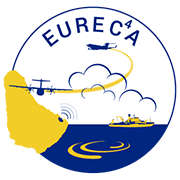EUREC⁴A
Area of field operations, showing 'Tradewind Alley' the central measurement area in a semi-circle defined by the Barbados-based Polarized C-Band Radar, PolidiRad. Additional research vessels will contribute to these measurements while also exploring the influence and evolution of ocean eddies that frequently ramble, toward Barbados from the SouthEast, along the "Boulevard des Tourbillons" .
EUREC4A, the Field Study, is an international initiative in support of the World Climate Research Programme's Grand Science Challenge on Clouds, Circulation and Climate Sensitivity. EUREC4A will take place between 20 January and 20 February 2020 with operations based out of Barbados.
EUREC4A aims at advancing understanding of the interplay between clouds, convection and circulation and their role in climate change: How resilient or sensitive is the shallow cumulus cloud amount to variations in the strength of convective mixing, surface turbulence and large-scale circulations? How do the radiative effects of water vapor and clouds influence shallow circulations and convection? To what extent do mesoscale patterns of convective organization condition the response of clouds to perturbations? And what are the implications of all of the above for how clouds respond to warming?
The Broader Context
To address these questions EUREC4A will focus on quantifying how cloudiness in shallow cumulus layers responds to changes in the large-scale environment and how shallow clouds affect radiant energy transfer for different forms of convective organziation. The measurements will also test retrievals of cloud and atmospheric properties, and numerical simulations of shallow cumulus cloud regimes by large-eddy simulation, weather prediction and climate models. Through international cooperation a number of associated studies will be explored in coordination with EUREC4A. These enlarge the scope of questions the EUREC4A family of measurement swill address to include: investigations of the  role of ocean mesoscale eddies in air-sea interactions and the organization of shallow clouds,
role of ocean mesoscale eddies in air-sea interactions and the organization of shallow clouds,  studies of stable water isotopologues as a way to inform understanding of atmospheric processes, studies of cloud microphysical processes, including aerosol-cloud interactions, an exploration the
studies of stable water isotopologues as a way to inform understanding of atmospheric processes, studies of cloud microphysical processes, including aerosol-cloud interactions, an exploration the  role of shallow convection in determining the distribution of winds. EUREC4A involves the deployment of three research aircraft (the German
role of shallow convection in determining the distribution of winds. EUREC4A involves the deployment of three research aircraft (the German  HALO, the French
HALO, the French  ATR-42, and the UK
ATR-42, and the UK  Twin Otter), in coordination with surface based measurements from the Barbados Cloud Observatory (
Twin Otter), in coordination with surface based measurements from the Barbados Cloud Observatory ( BCO) and the
BCO) and the  R/V Meteor which will be stationed upwind of Barbados, to quantify the distribution of clouds as a function of their large-scale environment. These measurements will be complemented by additional ship-board measurements from the
R/V Meteor which will be stationed upwind of Barbados, to quantify the distribution of clouds as a function of their large-scale environment. These measurements will be complemented by additional ship-board measurements from the  R/V L'Atalante and
R/V L'Atalante and  R/V Maria S. Merian, as well as a wide array of auntonomous vehicles (drones), and state-of-the-art turbulence-resolving modelling (100 m, over thousands of km). Both the NOAA
R/V Maria S. Merian, as well as a wide array of auntonomous vehicles (drones), and state-of-the-art turbulence-resolving modelling (100 m, over thousands of km). Both the NOAA  WP-3D and the
WP-3D and the  R/V Ronald H. Brown which will participate in EUREC4A as part of the NOAA funded
R/V Ronald H. Brown which will participate in EUREC4A as part of the NOAA funded  ATOMIC project. The planned operations build on a decade of measurements in the tropical Atlantic, initiated with the establishment of the Barbados Cloud Observatory in 2010, and continued with two aircraft campaigns with HALO: NARVAL in December 2013, and NARVAL2 in August 2016 (information about
ATOMIC project. The planned operations build on a decade of measurements in the tropical Atlantic, initiated with the establishment of the Barbados Cloud Observatory in 2010, and continued with two aircraft campaigns with HALO: NARVAL in December 2013, and NARVAL2 in August 2016 (information about  NARVAL experiments is provided here).
NARVAL experiments is provided here).
Operations:
EUREC4A operations will focus on an area over the shelf oceans east of Barbados (57 W 13 N) for a six week period between 12 Jan and 23 Feb 2020, with aircraft operations between 18 Jan to 16 Feb 2020. Through ATOMIC the R/V Ron Brown will begin measurements commencing on 6 January 2020. More information about EUREC4A is provided in an  overview paper describing the field study.
overview paper describing the field study.

